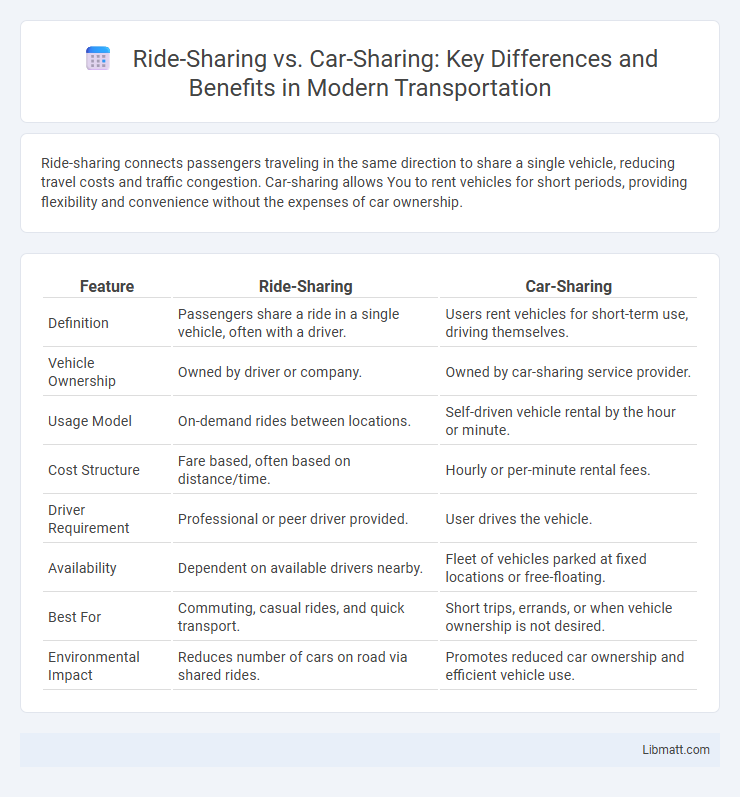Ride-sharing connects passengers traveling in the same direction to share a single vehicle, reducing travel costs and traffic congestion. Car-sharing allows You to rent vehicles for short periods, providing flexibility and convenience without the expenses of car ownership.
Table of Comparison
| Feature | Ride-Sharing | Car-Sharing |
|---|---|---|
| Definition | Passengers share a ride in a single vehicle, often with a driver. | Users rent vehicles for short-term use, driving themselves. |
| Vehicle Ownership | Owned by driver or company. | Owned by car-sharing service provider. |
| Usage Model | On-demand rides between locations. | Self-driven vehicle rental by the hour or minute. |
| Cost Structure | Fare based, often based on distance/time. | Hourly or per-minute rental fees. |
| Driver Requirement | Professional or peer driver provided. | User drives the vehicle. |
| Availability | Dependent on available drivers nearby. | Fleet of vehicles parked at fixed locations or free-floating. |
| Best For | Commuting, casual rides, and quick transport. | Short trips, errands, or when vehicle ownership is not desired. |
| Environmental Impact | Reduces number of cars on road via shared rides. | Promotes reduced car ownership and efficient vehicle use. |
Understanding Ride-Sharing and Car-Sharing
Ride-sharing connects multiple passengers traveling along similar routes, allowing them to share a single vehicle, reducing costs and traffic congestion. Car-sharing provides users access to vehicles on a short-term basis without ownership, promoting flexible, eco-friendly urban mobility. Both models leverage technology platforms to optimize resource use and enhance transportation efficiency.
How Ride-Sharing Works
Ride-sharing connects passengers traveling in the same direction, allowing them to share a single vehicle and split costs efficiently. Through mobile apps, you can easily find nearby drivers offering rides along your route, making your commute more affordable and environmentally friendly. This system reduces traffic congestion and lowers carbon emissions by maximizing vehicle occupancy.
How Car-Sharing Works
Car-sharing provides members access to a fleet of vehicles parked throughout a city, which can be reserved via a mobile app for short-term use by the hour or minute. Users unlock vehicles using smartphone technology, allowing them to pick up and drop off cars at designated spots without the need for rental counters. This model optimizes vehicle utilization, reduces the need for personal car ownership, and supports urban mobility with reduced traffic congestion and greenhouse gas emissions.
Key Differences Between Ride-Sharing and Car-Sharing
Ride-sharing involves passengers sharing a vehicle driven by a third party, often arranged through apps like Uber or Lyft, while car-sharing provides you with access to a vehicle that you drive yourself, such as services offered by Zipcar or Turo. Key differences include control and convenience: ride-sharing requires no driving on your part but depends on driver availability, whereas car-sharing offers greater independence and flexibility but requires a valid driver's license. Pricing models vary, with ride-sharing typically charging per ride and car-sharing charging by the hour or day, influencing your choice based on travel frequency and duration.
Cost Comparison: Ride-Sharing vs Car-Sharing
Ride-sharing typically incurs variable costs based on distance and time, often making it more expensive for frequent use compared to car-sharing, which charges hourly or daily rates that can be more economical for longer or multiple trips. Car-sharing reduces expenses related to vehicle maintenance, insurance, and fuel, as these are included in the rental price, whereas ride-sharing users pay these indirectly. Evaluating cost efficiency depends on trip frequency, duration, and purpose, with car-sharing generally preferred for planned, extended use and ride-sharing favored for spontaneous, short-distance travel.
Convenience and Accessibility
Ride-sharing platforms offer increased convenience by enabling users to book rides instantly through mobile apps, making transportation accessible in urban and suburban areas without ownership responsibilities. Car-sharing services provide flexible access to vehicles parked nearby, ideal for short-term use and spontaneous trips, often integrating seamless digital reservations and keyless entry. Both models improve urban mobility by reducing the need for private car ownership and offering scalable transportation options tailored to diverse user needs.
Environmental Impact of Ride-Sharing and Car-Sharing
Ride-sharing and car-sharing both reduce vehicle emissions by lowering the total number of cars on the road, yet car-sharing tends to have a greater environmental impact due to promoting full trips with fewer miles driven per user. Ride-sharing can increase congestion in urban areas because of frequent route deviations and vehicle idling between passengers, slightly offsetting its emissions benefits. Studies show that car-sharing leads to higher reductions in carbon footprint as it encourages users to rely more on alternative transportation modes, ultimately decreasing private car ownership.
Safety and Regulatory Considerations
Ride-sharing services, like Uber and Lyft, operate under strict regulatory frameworks requiring driver background checks, vehicle inspections, and insurance mandates to ensure passenger safety. Car-sharing platforms typically emphasize vehicle maintenance standards and member verification processes to reduce liability and enhance security. Your choice between ride-sharing and car-sharing should consider the specific safety protocols and compliance with local transportation regulations to mitigate risks.
Popular Ride-Sharing and Car-Sharing Services
Popular ride-sharing services like Uber and Lyft offer on-demand transportation by connecting passengers with drivers through mobile apps, providing convenient and flexible travel options. Car-sharing platforms such as Zipcar and Turo allow users to rent vehicles for short periods, giving you access to cars without ownership responsibilities. Both models promote cost-effective and eco-friendly alternatives to traditional car use, catering to different mobility needs.
Choosing the Best Option for Your Needs
Ride-sharing services like Uber and Lyft offer convenience for short trips and social rides, making them ideal for urban commuters seeking flexibility without vehicle ownership. Car-sharing platforms such as Zipcar and Turo provide access to a personal vehicle for extended use, perfect for users requiring more control and independence during their travel. Selecting between ride-sharing and car-sharing depends on factors like trip duration, cost efficiency, and personal convenience preferences.
ride-sharing vs car-sharing Infographic

 libmatt.com
libmatt.com